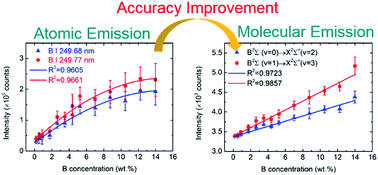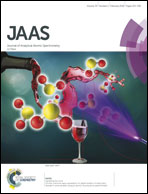Accuracy improvement of boron by molecular emission with a genetic algorithm and partial least squares regression model in laser-induced breakdown spectroscopy
Abstract
Laser-induced breakdown spectroscopy (LIBS) is an atomic emission spectrometry technique for material component analysis. However, the spectral signal distortion and the low analytical accuracy remain as challenges due to the self-absorption effect of atomic lines in LIBS. Here, to overcome this flaw, we demonstrated a method to build calibration with molecular emission, which was measured from a mixture of H3BO3 and C6H12O6·H2O in powder form. We compared the calibration established by typical atomic emission and molecular emission of boron monoxide. The results showed that the self-absorption effect and R2 values were improved by using molecular spectra. Furthermore, to improve the accuracy of molecular emission content determination, a genetic algorithm and partial least squares regression (GA-PLSR) combination model was adopted. The achieved root mean square error of prediction (RMSEP) and the mean prediction error (MPE) for the GA-PLSR model were 0.8667 wt% and 10.9685%, respectively. The results demonstrated that it is a potential method to overcome the self-absorption effect with molecular emission and the accuracy of boron content determination of molecular emission can be improved with the GA-PLSR model.



 Please wait while we load your content...
Please wait while we load your content...